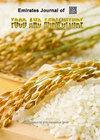Differential Expression of Oman’s Wild Lavender, Lavandula subnuda for Chemical Composition towards Medicinal and Aromatic Application
IF 0.7
4区 农林科学
Q3 AGRONOMY
引用次数: 0
Abstract
Plants have been used directly or indirectly as medicines for over 5000 years as a source of antibiotics, antineoplastics, analgesics, and cardio-protective, among others. Approximately 70–90% of the population in developing countries continue to use ancient medicines based on plant extracts for treatment. Recently, the isolation and identification of biologically active compounds and molecules from nature have led to the discovery of new therapeutics, prompting the improvement of the health and pharmaceutical sectors. Phytochemicals revolve around the pharmaceutical industry's research and development (R&D) sector as a source of new molecules leading to the development of new novel drugs. Given the above, the present investigation addresses the differential nature of wild lavender (Lavandula subnuda Benth) plants of diverse locations in Oman with respect to their chemical composition of the essential oil in addition to morphological characters and chlorophyll contents of leaves to explore the possibility of isolating its prime chemical compounds on a commercial scale in perfumery industry. There are no previous studies so far who have reported on essential oil recovery and chemical composition exclusively in respect of Lavandula subnuda. Composite samples of ten randomly selected plants were collected from wadi habitats of four diversified locations. Edaphic features of managed sites were recorded, and their soil chemical contents were determined following instructions using S1 Titan/Tracer 5/CTX equipment of Bruker developed based on energy dispersive X-ray fluorescence (EDXRF). Morphological traits were measured using a ruler, and chlorophyll contents were recorded using the atLEAF CHL Plus chlorophyll meter as atLEAF values. The essential oil was extracted using ETHO X's advanced microwave extraction system and analyzed for chemical compounds using GC-MS analysis on Shimadzu GC-2010 Plus gas chromatograph. The experimental data were analyzed statistically, wherever required, by applying basic statistics of the EXCEL -16 version. The results indicated that in general, the Lavandula subnuda plants of locations of high altitudes had higher expressivity in all the morphological traits and chlorophyll contents than those of low altitudes. The essential oil recovery, however, was found to be higher from the plant samples of lower altitudes (0.70 to 0.79% (w/w)) than from those of higher mountains/ altitudes (0.15 to 0.18% (w/w)). The pattern of values of commonly occurring chemical contents of essential oils was different. Each essential oil's top ten chemical compounds contributed about 80% of the total in four locations. Of the ten top chemical compounds, eight compounds, namely D-Germacrene (42.67%) from Wadi Al-Khod, Estragole (32%) and Linalool (23.89%) from Wadi Halban), trans-Borneol (23.46%) and 4-Terpineol (18.73%) from Wadi Najd Al-Waqba and Kessane (18.60%), beta-cis-Caryophyllene (13.68%) and beta-Elemene (10.618%) from Wadi Al-Hayul, were found highest in quantity and had huge potential for further application. It is concluded that there exists a higher possibility of adapting Good Agriculture Practice (GAP) to produce the highest herbage yield of vegetative parts of Lavandula subnuda plants based on morphological features under wild conditions to extract these compounds on a commercial scale in both the pharmaceutical and perfumery industries. Keywords: Morphology, Chlorophyll, Chemical compounds, Differential Expression, Lavandula subnuda,, Lamiaceae差异表达阿曼野生薰衣草(Lavandula subnuda)的化学成分,促进药用和芳香应用
植物作为抗生素、抗肿瘤药、镇痛药和心脏保护药等的来源,直接或间接用作药物已有 5000 多年的历史。在发展中国家,约 70-90% 的人口仍在使用基于植物提取物的古老药物进行治疗。最近,从大自然中分离和鉴定生物活性化合物和分子的工作导致了新疗法的发现,推动了健康和医药行业的发展。植物化学物质作为新分子的来源,在制药业的研发部门中发挥着重要作用,从而促进了新型药物的开发。有鉴于此,本调查针对阿曼不同地点的野生薰衣草(Lavandula subnuda Benth)植物,除了叶片的形态特征和叶绿素含量外,其精油的化学成分也存在差异,以探索在商业规模上分离其主要化学成分用于香水工业的可能性。迄今为止,还没有专门针对亚种薰衣草精油回收率和化学成分的研究报告。研究人员从四个不同地点的瓦迪栖息地随机采集了十种植物的复合样本。记录了管理地点的土壤特性,并按照说明使用布鲁克公司基于能量色散 X 射线荧光(EDXRF)技术开发的 S1 Titan/Tracer 5/CTX 设备测定了土壤中的化学成分。形态特征用尺子测量,叶绿素含量用 atLEAF CHL Plus 叶绿素仪记录为 atLEAF 值。使用 ETHO X 先进的微波萃取系统萃取精油,并使用岛津 GC-2010 Plus 气相色谱仪进行 GC-MS 分析。在需要的情况下,应用 EXCEL -16 版本的基本统计方法对实验数据进行统计分析。结果表明,总体而言,高海拔地区的亚种薰衣草植株在所有形态特征和叶绿素含量方面的表现力均高于低海拔地区的植株。然而,低海拔地区植物样本的精油回收率(0.70% 至 0.79%(重量比))高于高海拔地区的样本(0.15% 至 0.18%(重量比))。精油中常见化学成分含量的变化规律也不尽相同。在四个地方,每种精油的前十种化学成分约占总含量的 80%。在这十大化学成分中,有八种化合物,即 Wadi Al-Khod 的 D-革马芘(42.67%)、Wadi Halban 的雌甾醇(32%)和芳樟醇(23.89%)、反式龙脑(23.46%)和 4-松油醇(18.73%)。从 Wadi Najd Al-Waqba 和 Kessane(18.60%)提取的反式龙脑(23.46%)和 4-松油醇(18.73%)、从 Wadi Al-Hayul 提取的 beta-顺式茶叶烯(13.68%)和 beta-榄香烯(10.618%)含量最高,具有巨大的进一步应用潜力。结论是,根据野生条件下薰衣草植物无性部分的形态特征,采用良好农业规范(GAP)生产出最高产量的草本植物,在制药和香水工业中提取这些化合物的商业规模存在着更大的可能性。 关键词形态 叶绿素 化合物 差异表达 亚种薰衣草 唇形科
本文章由计算机程序翻译,如有差异,请以英文原文为准。
求助全文
约1分钟内获得全文
求助全文
来源期刊

Emirates Journal of Food and Agriculture
AGRONOMYFOOD SCIENCE & TECHNOLOGY&nb-FOOD SCIENCE & TECHNOLOGY
CiteScore
1.80
自引率
0.00%
发文量
18
期刊介绍:
The "Emirates Journal of Food and Agriculture [EJFA]" is a unique, peer-reviewed Journal of Food and Agriculture publishing basic and applied research articles in the field of agricultural and food sciences by the College of Food and Agriculture, United Arab Emirates University, United Arab Emirates.
 求助内容:
求助内容: 应助结果提醒方式:
应助结果提醒方式:


